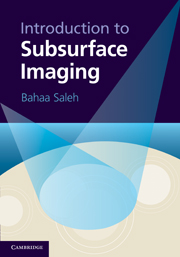Book contents
- Frontmatter
- Contents
- Authors and Contributors
- Preface
- Acknowledgements
- Outline and Roadmap
- 1 Overview
- 2 Physical Models
- 3 Localized Imaging
- 4 Tomographic Imaging
- 5 Digital Image Processing
- 6 Spectral Imaging
- 7 Mosaicing, Change Detection, and Multisensor Imaging
- 8 Numerical Simulation
- 9 Design of Subsurface Imaging Systems
- A Multi-Dimensional Signals and Systems
- B Linear Algebra
- C Detection and Classification
- D Software Tools
- Index
5 - Digital Image Processing
Published online by Cambridge University Press: 05 June 2012
- Frontmatter
- Contents
- Authors and Contributors
- Preface
- Acknowledgements
- Outline and Roadmap
- 1 Overview
- 2 Physical Models
- 3 Localized Imaging
- 4 Tomographic Imaging
- 5 Digital Image Processing
- 6 Spectral Imaging
- 7 Mosaicing, Change Detection, and Multisensor Imaging
- 8 Numerical Simulation
- 9 Design of Subsurface Imaging Systems
- A Multi-Dimensional Signals and Systems
- B Linear Algebra
- C Detection and Classification
- D Software Tools
- Index
Summary
This chapter addresses two topics: (i) discretization and matrix representation of imaging systems, i.e., digital imaging, and (ii) inversion of the imaging equation, i.e., reconstruction of the unknown object from the measured image for both localized and tomographic imaging systems.
Digital Imaging. In the imaging systems described in Chapters 3 and 4, the object and image distributions are described by continuous functions, f(r) and g(r), related by integral linear transformations. Also, image inversion was realized by means of analytical techniques based on continuous operations such as inverse filtering for shift invariant systems, as in Sec. 3.3, and inverse Radon transform for tomographic imaging systems based on projections, as in Sec. 4.1. For many imaging systems, explicit analytical methods for inverting the imaging equations do not exist. Also, in reality, an image is detected by a finite number of sensors providing discrete data, which may not contain sufficient information for adequately approximating the transform techniques discussed in Chapters 3 and 4. In ray tomography, for example, when the number of projections is small, the quality of inversion becomes poor, as described in Sec. 4.1B. In these situations, it is useful to also discretize the object function f(r) and represent the imaging equation (the relationship between the finite number of observed measurements and the elements of the discrete object function) by a linear set of algebraic equations. This discretization process converts the continuous imaging model into a digital imaging model relating the array g of the observed measurements to the array f representing the object.
- Type
- Chapter
- Information
- Introduction to Subsurface Imaging , pp. 189 - 230Publisher: Cambridge University PressPrint publication year: 2011

